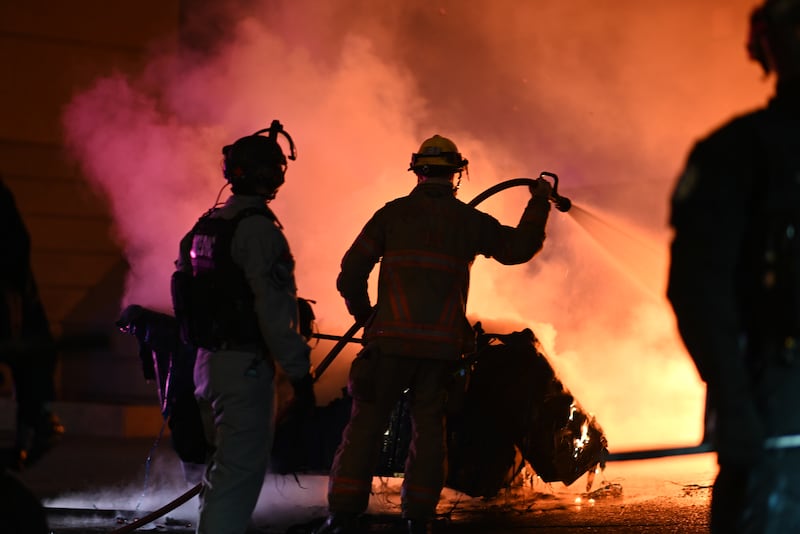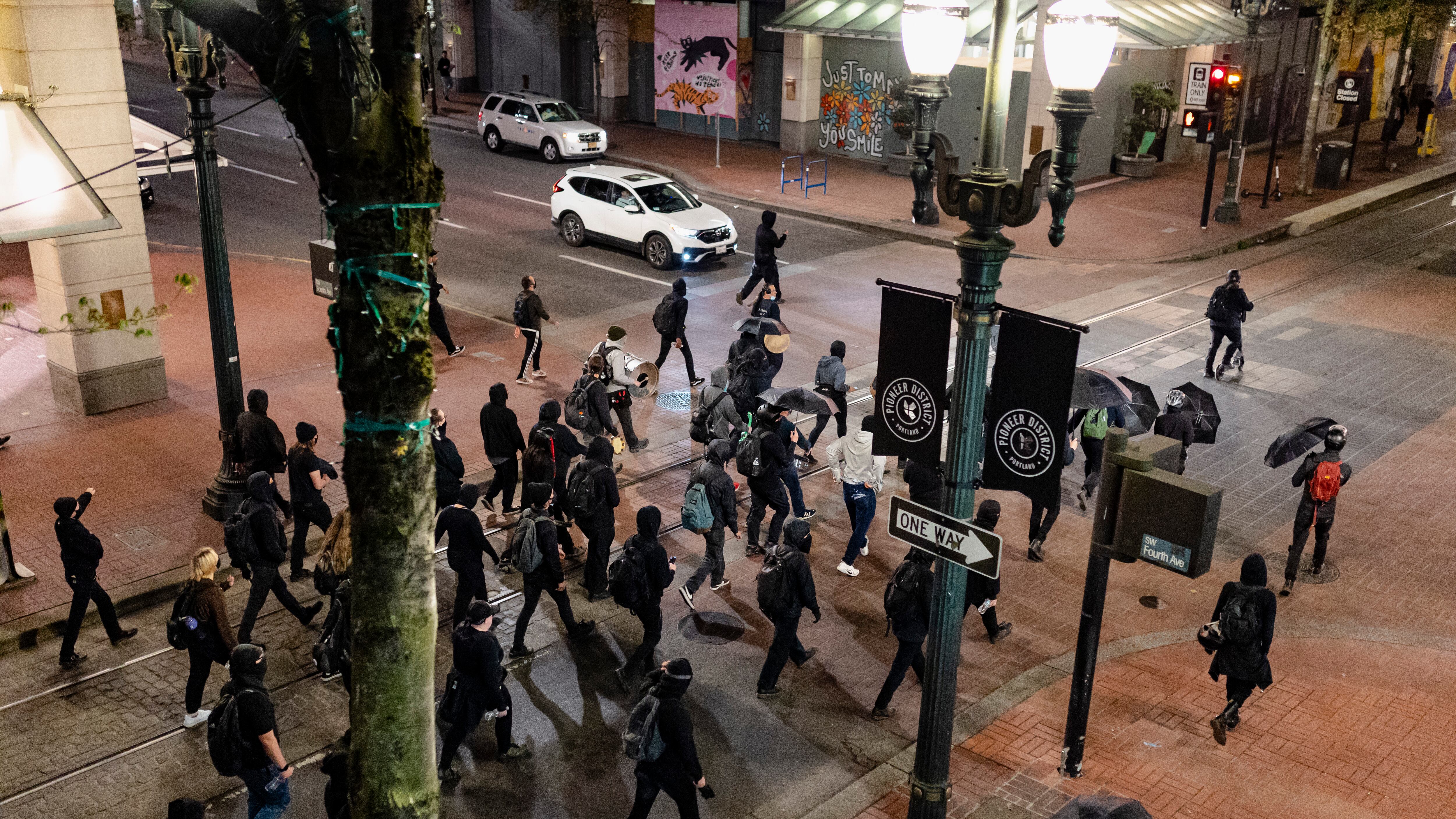About 45 minutes before sunset on May 25—the one-year anniversary of the murder of George Floyd—approximately 100 protesters gathered outside of the Multnomah County Justice Center in downtown Portland. Many followed the typical dress code: black shirt, black pants, black mask.
The sea of identity-concealing dark clothing, known as “black bloc,” provides a sense of anonymity and uniformity that can be further enhanced by rules that ban livestreamers and restrict the press.
But protesters’ ability to camouflage themselves cuts both ways: Somebody in or near the crowd was talking to the cops.
Prosecutors allege that 21-year-old Jarrid Huber, who once worked as a truck loader for Columbia Sportswear’s warehouse and who lives in Damascus, Ore., pushed a dumpster against the Justice Center and set fire to material inside it on May 25. Huber now faces charges for arson, criminal mischief and riot.
The evidence against him hinges almost exclusively on testimony from a pair of confidential informants who were located within or near the crowd.
A person identified as “Informant #1” told Portland Police Bureau Detective Meredith Hopper they saw Huber push the dumpster against the building and set its contents ablaze, according to a probable cause affidavit filed May 26 in Multnomah County Circuit Court. The first informant allegedly described Huber’s clothing in detail and provided police with photographs of the fire.
Meanwhile, someone described as “Informant #2” followed Huber as he marched through the city with “a large group of anarchist[s],” court records say. This informant said Huber spray-painted “anarchist symbols” on buildings and used a fence post to shatter the windows of a Starbucks and a jewelry store.
Huber’s case isn’t unique.
WW reviewed probable cause affidavits for Portland protesters who’ve been charged with crimes in the past two months. Of the 18 cases WW found from April and May for which documents detailing arrests were available, nine—exactly half—relied on information provided by “confidential reliable informants,” or unnamed witnesses known to police. Another two appear to be undercover police officers.
By contrast, WW could find no mention of informants in court filings for protesters charged in 2020 and the early part of 2021.
“This is very unusual,” says Chris O’Connor, a public defense lawyer who’s worked in the Multnomah County court system since 2004. He added that he suspects some of the people described as “informants” might be undercover cops. “Which is completely bizarre. That is totally novel in my experience in Multnomah County.”
Police use of confidential informants is a long-standing practice, especially when trying to bust up organized crime and drug operations. (In fact, PPB’s Narcotics & Organized Crime Unit oversees the bureau’s use of informants, according to its policy directives.)
But what’s striking is how many recent high-profile cases against Portland protesters accused of damaging property rely almost solely on the eyewitness testimony of sources blending into the black bloc.
The same night police arrested Huber, they also picked up Elizabeth and Emery Hall, ages 29 and 30. Arresting documents for Elizabeth Hall say a confidential informant witnessed “two subjects among the crowd that caused extensive property damage” to City Hall.
“The confidential informant observed Elizabeth Hall break out windows and graffiti the building,” the probable cause affidavit says. It further alleges that police found spray paint and a white marker in Elizabeth Hall’s backpack. (Court records for Emery Hall cite observations by police—not informants.)
And during May Day protests last month, “a person known to law enforcement as a reliable source” told police they witnessed 37-year-old Phoebe Loomis smash the windows of two different Starbucks as well as the Sassy Spa.
“Loomis was tracked and eventually arrested by uniformed officers,” deputy district attorney Mariel Mota said in a probable cause affidavit. “Officers found a bent metal bar on her person.” She now faces charges for riot and criminal mischief.
In addition, a probable cause affidavit filed May 3 for 20-year-old Quang Nguyen shows an acknowledgement by the Multnomah County District Attorney’s Office of undercover officers embedded in marches.
“I know from speaking to senior deputy district attorney Nathan Vasquez that to investigate violent actors who are using the cover of a protest in order to commit crimes, that law enforcement is often autonomously present inside the crowd,” deputy DA Kevin Demer wrote. “SDDA Vasquez told me that during the riot that occurred on May 1, 2021, where the Starbucks located [downtown] had some windows broken, that it was a Portland Police Bureau officer who told PPB Officer Ross Doramdy what he saw. In Ofc. Dormady’s report, he refers to this person providing information as ‘a witness known to me.’”
Using confidential informants to charge Huber, Hall and Loomis serves two purposes for police and prosecutors: It takes protesters bent on property destruction off the streets, and it creates an atmosphere of suspicion among remaining protesters, who don’t know if the masked person next to them is talking to the cops.
“This is partially a psychological warfare tactic,” said Juan Chavez, a Portland civil rights lawyer. “What I think is new is announcing that you’re using an informant. The effect goes beyond the indictment to instill fear.”

The use of confidential informants at protests appears to reflect a strategic shift by law enforcement beginning in the early spring.
On March 15, three days after the Police Bureau detained nearly 100 protesters via a technique known as “kettling,” Mayor Ted Wheeler held a press conference in which he issued a warning to what he described as the 150 or so protesters who continually destroy property.
“We want you to know that we’re aligning our resources, we’re revising our tactics, and we’re fighting back with everything that we’ve got,” Wheeler said. “The community is sick and tired of people engaging in acts of criminal destruction and violence, and doing it under the guise of some noble cause.”
Within weeks, cases began appearing in Multnomah County Circuit Court that relied heavily on the testimony of unnamed witnesses who are described as being “known to law enforcement” with a history of providing “credible and reliable information” to police. In court records, these witnesses claim they observed property damage from a close distance—so close it’s hard to imagine they weren’t in black bloc garb themselves.
Those cases include Alma Raven-Guido, accused of setting a fire near the doorway of the Portland Police Association’s headquarters on April 13, and Emma Lightstone and Emily Keppler, who allegedly used a hammer to smash a Bank of America ATM screen as well as windows at a U.S. Bank branch on April 19.
The DA’s office declined to respond to questions about the use of informants in protest cases. “We don’t comment on the sources or means of ongoing investigations,” said spokesman Brent Weisberg.
The Police Bureau did not respond in detail to questions about its use of confidential informants during protests. Citing Oregon law, PPB spokesman Sgt. Kevin Allen says the bureau considers it appropriate to use confidential informants when “there are reasonable grounds to suspect the subject of the information is or may be involved in criminal conduct.”
Asked how the bureau distinguishes between what it considers a legitimate protest and a criminal gathering masquerading as such, PPB spokesman Lt. Greg Pashley said, “That distinction is made if crimes are committed.”
The distinction is significant. It’s at the center of a rift among Portlanders who disagree on a fundamental question: Is it proper to categorize repeated gatherings that result in broken windows and graffiti as protests? Or, as the Police Bureau and the mayor have posited, are these events better defined as coordinated, criminal activity happening under the guise of protest?
The mayor’s office tells WW that its priority is to protect the right of free speech, but that there is a difference between protesting and engaging in criminal activity.
“These ‘direct action’ gatherings invite the assembled groups to engage in the criminal acts of property destruction. Largely these gatherings take place at night with those gathered all dressed the same, in black clothes with all faces covered,” said spokesman Tim Becker. “The use of confidential informants ensures that we arrest the correct person for an actual suspected property and/or person crime.”
The rise in the use of confidential informants is also occurring as the black bloc marches are losing public favor, even in activist circles, following repeated incidents of property destruction this year. On April 20, 57 Black protesters penned an open letter condemning the repeated property destruction and calling the behavior “detrimental to Black Liberation.”
Nighttime marches can be marked by open arguments between different protester groups trying to demonstrate at the same times and locations.
It’s unlikely that arguments over tactics are causing activists to run to the cops, their avowed adversary. But the number of charges some repeat participants have racked up could give prosecutors leverage over witnesses who would rather cooperate than spend time in prison. In fact, PPB’s policy directive manual has a specific carve-out for what’s called “case consideration” for informants charged with a crime.
And beyond that, repeatedly prosecuting protesters using confidential informants has an added side effect on the social dynamic: sowing discord and fear among the crowd.
At around 9:30 pm on May 25—at the same protest where Huber and the Halls were arrested—riot cops secured the intersection at Southwest 3rd Avenue and Main Street to extinguish a flaming dumpster.
The crowd fell into disarray as protesters argued about what to do next. Some wanted to stay, while others wanted to march through downtown. The arguing grew until one protester accused another of being a cop.
“Let’s get away from that police officer,” the first protester said, referring to the other.
“Who called me a fucking cop?” the second retorted. “Who said that?”
By then it was too late. Protesters had already begun walking away, splintering the once unified crowd.
Justin Yau contributed reporting to this story.

